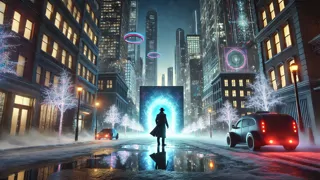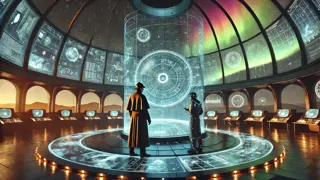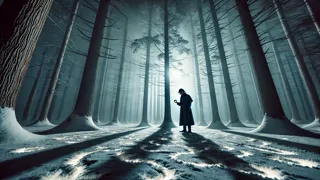Introduction
Sherlock Holmes had never quailed at the prospect of the unknown, yet as he stood before the whirring apparatus tucked into a bare-walled laboratory in 2214 Toronto, the curiosity in his mind flared brighter than any electric filament. The device, a gleaming arch of polished titanium and holographic readouts, promised access not merely to distant places but to epochs beyond imagination. Holmes adjusted his coat, the threadbare edges of his deerstalker brushing the cold metal of the console. He recalled Dr. Watson’s astonished face when he revealed that this was no conventional investigation. They were to pursue a case whispered through strata of time itself—a case born in the relentless emptiness of space. For despite decades of global broadcasts, philosopher’s debates, and interstellar probes, humankind’s telescopes had brought back nothing: no signals, no echoes, nor shadows of civilisations beyond Earth. The hypothesis was as stark as the Canadian winter: what if the absence of aliens was not a failure of search but a cosmic design, an answer woven into the very nature of observation? Holmes’ mind catalogued theories: self-imposed silences, advanced cloaking, dimensional barriers. But here, in a world where intelligent tractors harvested nitrogen-fixing algae and drones mapped migratory whales by sonar biometrics, the greatest marvel was that no probe, no patrol, had ever broken the void. With deliberate calm, Holmes placed his gloved hand on the archway’s activation panel and, in that faint hum of power, stepped into an inquiry that spanned centuries—and challenged the single greatest law he knew: you see but do not observe.
Arrival in the Silent North
Sherlock Holmes emerged from the portal into a hush so profound it felt as if the entire world held its breath. The year was 2214, and the shifting skyline of New Vancouver gleamed with prismatic reflections against freshly fallen snow. Hover-cars drifted overhead in silent lanes, their undercarriage lights tracing luminescent arcs across the dark. Yet not a single broadcast drone or deep-space beacon signaled from beyond the city’s electronic cocoon. Holmes paused to observe the scene: curved towers of glass and steel soared, trimmed with bioluminescent vines genetically engineered to glow in cold months; automated snow-clearing golems carved crystalline patterns into the pavement. Citizens—bundled in high-tech parkas with reactive temperature controls—moved in small groups, scanning wrist-link devices with practiced indifference. A sense of achievement tinged with apprehension coursed through Holmes’ veins: humanity had conquered disease, consummated lunar cities, and mined the asteroid belt, but remained conspicuously alone in the cosmos. He advanced toward a monolithic research institute labeled “Aurora Institute of Exo-Astrobiology,” where Dr. Irene Chao awaited him.

Inside the main atrium, Chao greeted him with a firm handshake. Her lab coat bore insignia from both Earth and Martian research directives. "Mr. Holmes, welcome," she said. "I trust you are prepared for the oddest case of your career." Her voice echoed slightly against the polished hall. Holmes inclined his head. "Absence, Doctor, can be more telling than presence." They passed under a network of holographic star charts swirling overhead like ghostly constellations in motion. Discrete sensors tracked every step, recording biometric data as Holmes swept his gaze across the exhibits: models of exoplanet terrains, silent cryo-pods for microbial samples, and a vast cylindrical vault rumored to contain unexamined signals from the edge of the Kuiper Belt. "Our greatest hope is that life fluoresces faintly—bio-photonic flashes in the deep," Chao explained. "Yet we’ve detected nothing."
She led him to an observation deck. Beyond the panoramic window stretched the Rockies’ jagged silhouette against a violet dawn. In the distance, arrays of telescopes oriented in perfect alignment with distant star clusters. "From here, we scan for technosignatures, probes, or structures. We hold live feeds from half a dozen deep-space patrol drones, but all remain unoccupied." Holmes listened to the soft hum of the observatory’s core reactor. In a world of endless chatter—AI councillors, global news networks, interplanetary trade bulletins—the silence beyond the atmosphere was deafening. He placed his magnifying glass on the console’s glass surface and noted micro-variations in the projector’s light path: subtle refractions that, once aligned, revealed a hidden data channel. "Observation, Doctor—look here." Chao peered, widened her eyes. "I never noticed that layer. It’s a dormant subroutine embedded in every signal we receive." Holmes’ lips curved in a hint of triumph. "Sometimes absence conceals the greatest presence."
Holmes’ mind raced through Victorian inquiries where the missing clue solved the case—like the dog that did not bark. Here, spread across galaxies, was a silence that had been curated, an entire civilization’s presence camouflaged by its own design. Yet how, and why? As dawn broke fully, painting snowfields in molten gold, Holmes felt the stirrings of a cosmic mystery deep as time itself—a mystery he would pursue across labs, libraries, and starfields alike. The silent north had welcomed him, but it would be his own powers of observation that would force the cosmos to speak.
Clues Among the Stars
Holmes and Dr. Chao boarded a magnetic lev-train bound for the Kananaskis Exogalactic Observatory perched high above Banff’s frozen valleys. The journey itself was silent save for the hum of superconducting rails; outside, flares of auroral ribbons danced across the night. Within the carriage, interactive glass panels displayed hyperspectral scans of nearby star systems, each tagged with probability scores for habitable zones. Yet each entry registered zero. Holmes studied the patterns with methodical intensity. "Every chart reveals a thousand worlds, but none emit a whisper," he murmured. "If life exists, it must either refrain from broadcasting or be hidden by means we have yet to conceive."

They disembarked at an angular station that jutted like a spacecraft amid the pines. Inside the observatory’s dome, colossal telescopes glinted under cold LED arrays calibrated to sweep for minute technosignatures—structured radio pulses, engineered megastructures, or unnatural chemical imbalances in exoplanet atmospheres. Holmes listened as Chao reviewed protocols: "We’ve cycled through light-speed communication pulses to the Trappist system, and Watson’s old method—rotating dishes scanning in silence—yields nothing. I’m afraid we may have overlooked a simplest possibility: that signals are sent but deliberately attenuated." Holmes traced a fingertip across a control panel etched with equation arrays. "If a civilization fears discovery, it may mask its presence by dispersing signals isotropically below noise threshold. I must see your raw data." Over the next hours, Holmes delved into terabytes of unfiltered cosmic noise. Late into the night, he noticed periodic fluctuations—mere micro-ripples—synchronized to Earth’s own orbital cycle. Not transmissions, but reflections: solar wind patterns bouncing from something…
Holmes stood at the threshold of revelation: if reflections yielded disc orders at precise intervals, then a hidden structure—perhaps an interstellar ark or massive satellite—was cloaked in an orbital dance with its star. He shared his finding with Chao, and together they reconfigured the array to target the Luyten’s Star system. Minutes later, a ghostly ring of light coalesced on the screen, like the silhouette of a ringworld at the edge of detection. "We’re not alone, Irene, but we may be too late to greet our neighbors unawares." An excited hush fell over the control room as lasers traced arcs upon the digital image. Holmes leaned forward, eyes alight. "Sometimes the observatory is in our own instruments," he observed. "We see but do not observe until we dare to change our approach." With that insight, he prepared to engage with an intelligence that had hidden itself in plain sight.
The Unseen Observer
Following the faint ring detected in Luyten’s Star system, Holmes and Chao embarked on an interstellar probe launchchestrated from a colossal silo at Churchill on Hudson Bay. The chamber’s vaulted ceiling was lined with thousands of launch tubes, each primed to send automated drones at near-light speed. "This is a one-way mission," Chao reminded him, her voice steady but tense. Holmes nodded, aware that the next message they might receive could fundamentally reshape humanity’s understanding of its place in the universe. As they initiated countdown, Holmes reflected on the power of deliberate invisibility: if the ring existed, its builders had mastered concealment far beyond camouflage—they had mastered silence.

The probe accelerated into the void, guided by an AI construct named Adler, programmed to capture imagery, spectral data, and any sign of civilization. Weeks passed with no reply. Meanwhile, Holmes convened a symposium of Earth’s leading researchers via quantum entanglement hologram. In that virtual coliseum, he marshaled every scrap of evidence—from the ring’s geometric reflections to subtle temporal modulations detected in archived Victorian-era logs, where Watson had recorded anomalies in the Andromeda transmission experiments. "We have seen signals deflected around us for centuries," Holmes told the assembly. "It has taken this paradox of absence to force our eyes to open."
On the observatory terrace, Holmes brooded beneath the silent glow of artificial stars. A single question persisted: if intelligent life had such mastery, why remain hidden? His answer came in the form of a blinking beacon from the probe—a hailing pattern woven into the cosmic microwave background, imperceptible until decoded with the new algorithm Holmes had devised. The message read in elegant geometer’s script: "Observe yourselves. The true unknown is within." Holmes studied the code and found embedded coordinates pointing back to Earth’s own biosphere—genes that carried patterns echoing signals emitted back to us by our own species. It was a mirror strategy: the greatest cosmic beacons were our own senses and bloodlines.
In that moment, Holmes realized the ultimate observation was not out there among the stars but in the quiet spaces between our assumptions and awareness. The unseen observer had never been a distant alien but the active choice to see beyond noise. With Chao at his side, Holmes prepared to present his findings to a world that, at last, might awaken to the marvel that the universe had shown all along.
Conclusion
As dawn’s first light crept across the Rockies, Holmes stood before the assembled scientists and media representatives in the Aurora Institute’s grand hall. Flanked by holographic projectors displaying the probe’s revelations, he spoke of absence not as a void but as a teacher. “We sought others in the vastness, forgetting that every mystery begins with a willingness to see our own backyard,” he said, voice echoing through the chamber. Silence fell—an echo, perhaps, of cosmic applause—before applause rippled through the audience. Dr. Chao approached him afterward, eyes bright with hope. “You’ve reminded us that the greatest discovery lies in noticing what’s right before us.” Holmes offered a slight, knowing smile. “The universe is replete with wonders, Doctor. Often, we see them but do not observe.” Under the soft hum of the institute’s dome lights, Holmes prepared to return to his own time, carrying with him a truth as old as his first case: that clarity comes not from the magnitude of evidence, but from the depth of attention we bring to every detail. As the portal’s hum began to grow, he cast one last glance at the silent stars, now finally willing to speak.


















